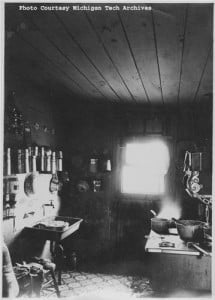I worked with a researcher in the Archives today who was interested in any records or documentation of foodways. What are “foodways,” you may ask. Well, that’s academe-speak for what people eat, the social implications of what, how, and with whom they eat; basically, how people interact with food. Food is love, right?
The researcher, Casey Rudkin, an RTC doctoral student, was looking for things like cookbooks and any records that might contain recipes. She was particularly interested in the Brockway Diaries Collection (MS-010), thinking that perhaps Lucena Brockway had noted “receipts,” as recipes were sometimes referred to in the early 19th century and prior. Lucena kept a pretty terse journal, but there are plenty of details to be gleaned of early life on the Keweenaw by the dedicated researcher.
Casey did the hard work, but occasionally we puzzled together over the meaning of some of the text in the diaries; Lucena was not the most legible scribe. We struggled over an entry that recorded the canning of a bushel of cherries, and eventually learned that on one autumn afternoon she and two other women put up 13 cans of cherries by 7 o’clock! No mean feat even on a modern gas range. I can only imagine what that was like on a wood stove in a kitchen without electricity or running water.

Lucena seemed to have been ill frequently. Many of her recipes deal with home remedies. One entry notes a “cure for small pox.”
Casey shared her notes with me from the final page of Lucena Brockway’s 1869 diary, written opposite the back cover page (Coll. #MS-010, The Brockway Diary Collection, Box 1, Folder 5). I’m posting it here with a disclaimer that the excerpt is intended for informational purposes only.
“Cure for Small Pox
Sulphate of zinc one grain;
Foxglove (digitalis) one grain;
half a teaspoonful of sugar;
mix with two tablespoonfuls of water.
When thoroughly mixed add—
four ounces of water.
Take a spoonful every
hour. Either disease
will disappear in twelve
hours. For a child smaller
doses according to age.
If counties would com
pel Physicians to use
this there would be no
need of Pest houses.”
Lucena notes that the remedy worked for Scarlet fever too.
As work continues on our NHPRC-funded project to create collection level descriptions for all of our manuscript collections, we are truly “revealing hidden collections.” Cataloging archivist Beth Russell was able to suggest another source that contained recipes or descriptions of food. In the collection of Perkins Burnham Correspondence (Acc. # 01-103A), a healthy young clerk in the Eagle Harbor general store describes meals at his boarding house with great gusto.
Mmmm, I’m getting hungry….